| Srl | Item |
| 1 |
ID:
117185
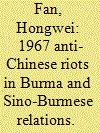

|
|
|
|
|
| Publication |
2012.
|
| Summary/Abstract |
Anti-Chinese riots broke out in Rangoon on 26 June 1967. The riots, which resulted from Chinese students' defiance of the Burmese government's ban on wearing Mao badges in school, led to the deterioration of Sino-Burmese relations, symbolised by the cessation of 'Pauk Phaw' ties and the subsequent shift in China's foreign policy which included open intervention in Burma's civil war. The riots contributed to estranged relations between Beijing and Rangoon throughout the 1970s and 1980s despite the normalisation of bilateral ties in 1970. While the roots of the Rangoon riots lay in Burma's political economy and tensions within the local Chinese community in the context of Cold War international relations, Beijing bore primary responsibility, however, due to its export of the Cultural Revolution.
|
|
|
|
|
|
|
|
|
|
|
|
|
|
|
|
| 2 |
ID:
087779
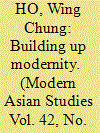

|
|
|
|
|
| Publication |
2008.
|
| Summary/Abstract |
This essay looked into how a group of residents in a Chinese community negotiated with the ideological tropes inscribed in the spatial, which aimed to build up state-people trust on the future course of national development. Under investigation was a slum-turned-socialist-model community called "Cucumber Lane" in two historical junctures in which its spatial settings were radically reorganized. It was argued that the two spatial reorganizations exemplified two major state-led projects of modernity, each of which entailed a specific representation of space that ideologically adumbrated a specific course of national development. It was found that while the residents welcomed the project of modernity launched in the 1960s with enthusiasm, they received the other in the 1990s largely with apathy, and even with mistrust and disbelief
|
|
|
|
|
|
|
|
|
|
|
|
|
|
|
|
| 3 |
ID:
133739
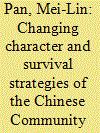

|
|
|
|
|
| Publication |
2014.
|
| Summary/Abstract |
The Chinese community has been settled in India for more than two centuries. Its relationship to the host society and to the authorities, first British and then Indian, has gone through different stages with different forms. It is important to examine the lives, traditions and attitudes of the Chinese community to understand its development and its changing character. This study argues that it is misleading to present this community as one that has always been marginalised and discriminated against in India. It examines the applicability of concepts such as 'sojourning', 'corridors' and 'middleman minority' to the community and its different sub-groups, both in British India and in post-independence India.
|
|
|
|
|
|
|
|
|
|
|
|
|
|
|
|
| 4 |
ID:
172616
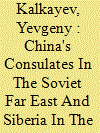

|
|
|
|
|
| Summary/Abstract |
The paper examines the position of the Republic China consulates in the Soviet Union in 1937-1938. During the Great Terror period. Chinese consulates found themselves in an ambiguous position. On the one hand, they represented a friendly state and were not closed down as many other foreign consulates were at the time. But on the other, NKVD charged many of their staff with working for the Japanese intelligence service, while the consulates' efforts to protect their nationals were viewed by the Soviet side as hostile.
|
|
|
|
|
|
|
|
|
|
|
|
|
|
|
|
| 5 |
ID:
126139
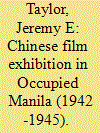

|
|
|
|
|
| Publication |
2013.
|
| Summary/Abstract |
This paper explores the nature of film exhibition amongst the Chinese community in Manila during the Japanese Occupation of that city. Based on advertisements and film listings published in the Chinese-language press of the day (as well as on pre-war records concerning commercial Chinese entertainment in the Philippines), it explores the continuities in film exhibition practice undertaken by various theatre operators within the Binondo area of Manila both before, during, and after the war. The paper suggests not only that such practices represented a quite different trajectory from that experienced in other parts of Occupied Manila, but also that a more thorough exploration of the Manila Chinese during wartime-one which goes beyond questions of mere collaboration and/or resistance-will encourage us to question some of the assumptions that underpin recent scholarship about this community.
|
|
|
|
|
|
|
|
|
|
|
|
|
|
|
|
| 6 |
ID:
176987
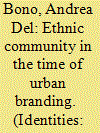

|
|
|
|
|
| Summary/Abstract |
This article proposes to look at the Chinese community as a contextual assemblage rather than an epistemic truth in discussing urban multiculturalism in the Sydney urban context. In doing so, it steers clear from the ‘groupist’ analytical framework for the study of ethnicity, and it rejects paradigms such as ‘the community’ as a collective distinguished by ‘a unique culture, held together by communitarian solidarity, and bound by shared identity’. A nuanced account of how the Chinese community becomes part of a system of value production is given, where acts of ‘consensus’ and ‘alignment’ are mobilised to embed its precarious formation within the branding strategies that aim to construct an ambiguous multi-Asian character for the precinct of Haymarket/Chinatown in the City of Sydney. These strategic positionings displace ethnicity understood as an essence, and the community as a taken for granted form of collective identification.
|
|
|
|
|
|
|
|
|
|
|
|
|
|
|
|
| 7 |
ID:
095244
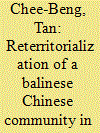

|
|
|
|
|
| Publication |
2010.
|
| Summary/Abstract |
This paper is about a special category of guiqiao or 'returned overseas Chinese', in southern Fujian. Arriving in China from Bali, Indonesia in 1961, the people were settled in an overseas Chinese farm. The paper illustrates how the re-migrants coped with life in China and how they see themselves today. The returned overseas Chinese reterritorize their Indonesian and Balinese cultural life in China, and they, including the local-born children, speak Balinese and eat Indonesian food. Their experiences provide much food for thought on acculturation, migration and identity as well as on the idea of 'homeland'
|
|
|
|
|
|
|
|
|
|
|
|
|
|
|
|